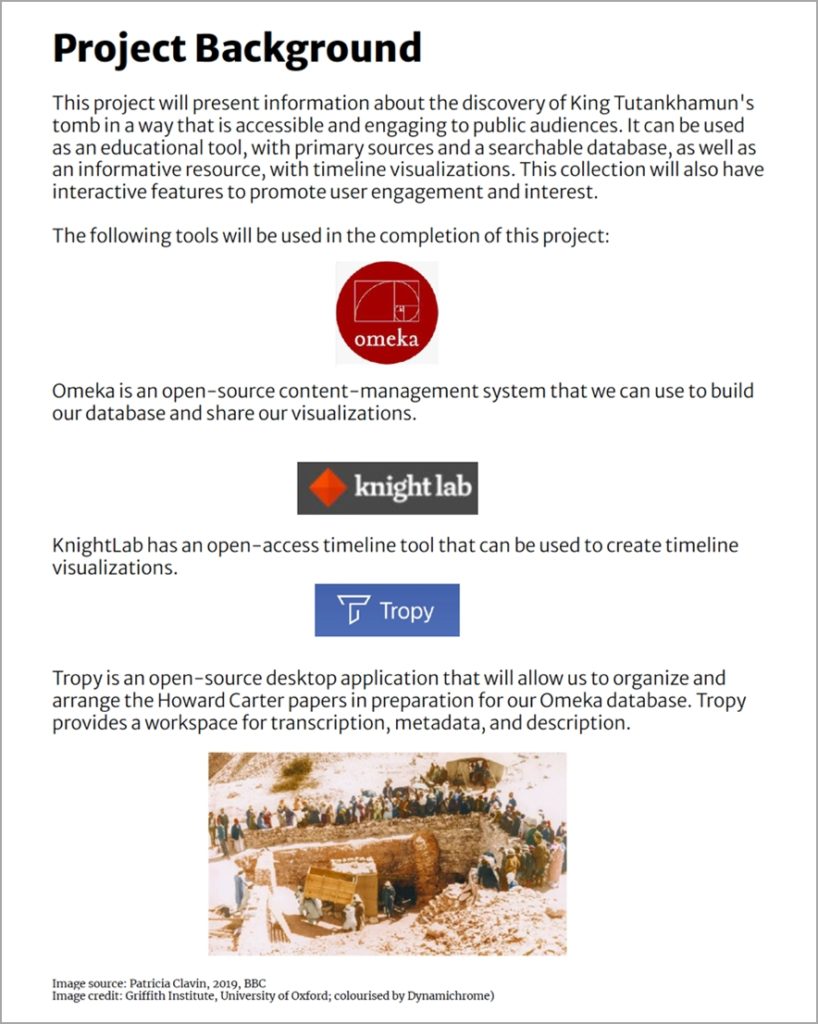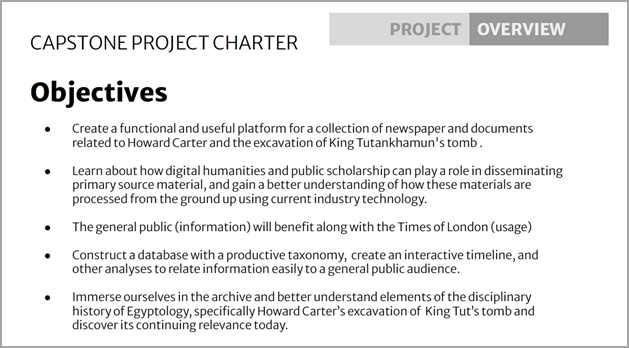|By Dr. Sarah Ketchley, Senior Digital Humanities Specialist|
As an affiliate faculty member at the University of Washington, I have been working with cohorts of students for over a decade in the field of digital humanities. My area of research expertise is Egyptology, specifically the disciplinary history of the field in the late nineteenth and early twentieth centuries. I work with students to transcribe, encode, and publish archival material from this period, mostly focusing on letters, diaries, and travelogues.
King Tut Centenary
2022 is a significant year for the study of Egyptology―it marks a century since the discovery of the tomb of Tutankhamun by archaeologist Howard Carter, who famously searched for Tut’s tomb in the Valley of the Kings for several years, sponsored by Lord Carnarvon. Finally, as patience and funding were running out, he uncovered the steps leading down to the tomb’s entrance on November 4, 1922, and went on to make headlines around the world.
To mark this occasion, I wanted to focus my research and teaching during the 2021–2022 academic year on the creation of a digital resource about the history of the tomb’s discovery. Gale Primary Sources includes The Times Digital Archive, which provides access to over 200 years of reporting since the paper began in 1785. This unique resource includes exclusive coverage of the discovery of King Tut’s tomb, based on an agreement with Lord Carnarvon that proved to be controversial at the time.
Making this collection of newspaper articles available in an accessible format provides an opportunity to contribute to the wealth of resources and experiences planned in Egypt and across the world, and to create a lasting record for scholars, students, and Egyptophiles to use and enjoy.

Omeka, Knight Lab’s TimelineJS, and Tropy.
iSchool Capstone Projects
The University of Washington’s iSchool offers a culminating capstone experience each year, where all graduating seniors design and implement a unique project to showcase their learning and skills. This year, I was fortunate to gather a team of four talented students who developed the “Tut Talks” project between January and May. One of the main aims was to use The Times Digital Archive to gather published reports of the discovery, then create an accessible online exhibit of this material, with associated transcriptions and metadata.
Thanks to the generosity of a private donor, we were also able to work with a collection of archival materials related to Carter’s time in Egypt, including letters to and from the archaeologist, his employment records, and notes for his memoirs. The process of organizing and transcribing this collection of material provided a unique opportunity to work with previously unpublished records, and to develop strategies and a workflow for transcription, metadata, and exhibit building.
My role as capstone sponsor included acting as the subject matter expert, providing access to primary source material, identifying what I hoped the deliverables would be, and meeting with the student team regularly to offer feedback and to troubleshoot any technical or historical issues that arose.
Building a Project

The iSchool structures the work in phases, providing students with a master Project Charter to complete. This is a space for students to document the objectives, scope, time line, and key deliverables for their project work, along with essential project-specific documentation, such as their team project charter and an evaluation of how the group and its sponsor will determine if the project has been a success.
The document also provides a framework for creating monthly status reports, which are an essential element to determine if the team is on track to complete the project on time, and if not, to determine what adjustments should be made to the project scope.

While this workflow was used for a project about a 1922 excavation in Egypt, the underlying theory and processes are relevant and useful for effective project work across a diverse range of fields and industries.
Pathways to Data Curation
Having completed the infrastructure for a project work and accountability, the hands-on work included considerable information gathering, sorting, and cataloging. The team developed a project taxonomy and implemented consistent metadata standards for each item in the digital collection. Relevant newspaper articles were gathered into custom content sets in Gale Digital Scholar Lab, and the metadata export feature enabled the team to download and develop detailed data spreadsheets that they then mapped to Omeka Dublin Core metadata fields as part of the process of creating their exhibits.
To provide accurate transcriptions of the original Times digital images, we determined that manual cleanup of the optical character recognition (OCR) text would be necessary. I put out a call for community volunteers via my research project’s Facebook page and through my community Nextdoor noticeboard. The team of volunteers we gathered was enthusiastic and detail oriented, hailing from the United States, Europe, Egypt, and Australia, and included retirees, educators, historians, and even crew members on my local ferry. The accurate transcriptions we provide are thanks entirely to their hard work.
Explore the Project
You can learn more about the completed project in this informational video, and visit the completed website here.
As well as the Times of London and the Howard Carter digital exhibit, the website also features two exhibits created by students in my 2022 Spring Quarter NEARE 498 class. These projects examine the cultural context and impact of the tomb’s discovery through the lens of “Egyptomania” and “The Pharaoh’s Curse and King Tutankhamun.” Gale Digital Scholar Lab was used extensively in these projects for data curation, cleaning, and analysis of both Gale Primary Sources material and text documents students uploaded into the platform. Check out the press release Gale issued today to learn more about this project. Additionally, the syllabus and workflow of the class will be discussed in this month’s The Gale Review’s “Notes from Our DH Correspondent” post.
All images courtesy of the Tut Talks MLIS team.


